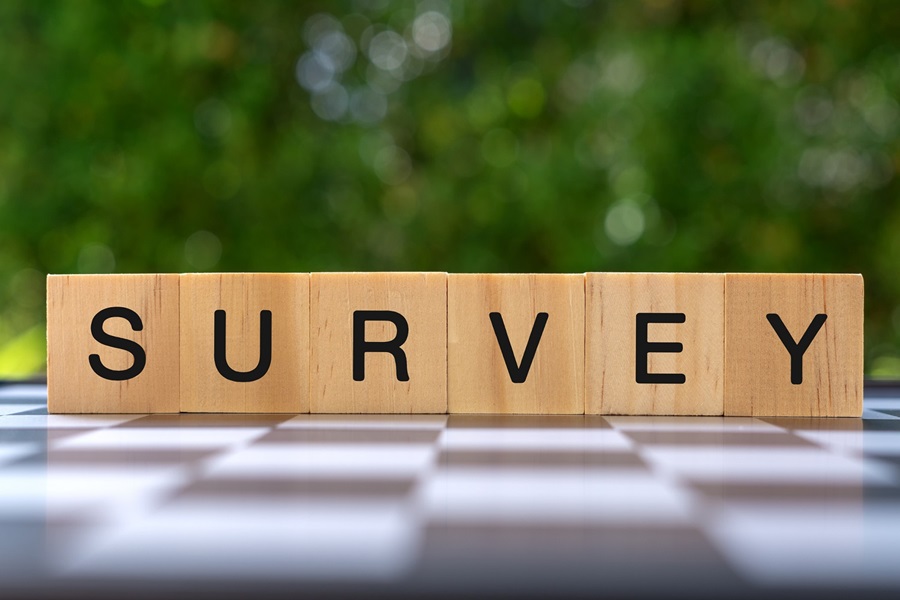Market research surveys are powerful tools that help companies better understand current and potential customers. This information can be used to make business decisions based on facts and data —not flimsy gut feelings. But how, exactly, do you go about conducting market research surveys? We answer this question and more below.
What are market research surveys?
Market research surveys are a reliable means of gathering insight into the people that matter most: your target audience. Put more simply, surveys help market researchers get to know current and potential customers. And in some cases, like new product launches, can help to determine who your customers are.
The type of information extracted from these surveys varies. However, businesses typically use market research surveys to collect demographic data as well as data related to consumer desires, beliefs, and purchasing behavior. For example, a company may develop a market research survey to evaluate brand awareness. Meanwhile, another company may design a market research survey to assess demand for a potential product.
It’s worth noting that market research surveys are an example of primary research. That means you are collecting information that hasn’t already been collected. Comparatively, secondary research involves using pre-existing data. For example, market researchers may reference census data.
Furthermore, it’s also important to note that the data collected through market research surveys is usually quantitative. This allows company executives to make quick, fact-based business decisions. For instance, information gleaned through a market research survey may show that customers in certain areas are willing to spend 50 percent more on a particular product. Companies can use this information to adjust pricing accordingly.
While online surveys are typically used to collect quantitative data, they can also be useful in collecting qualitative information as well. Market researchers achieve this by including open-ended questions that require panelists to type answers into a comment box. From there, market researchers can analyze the text manually or use text analysis tools.
Why use market research surveys?
Market research surveys provide a window into the consumer psyche, helping market researchers and end users better understand consumer wants, needs, and pain points. Companies can then use this information to develop products and services that resonate with the target market or better understand and respond to consumer concerns.
Simply put, market research surveys can boost the bottom line by helping businesses:
Research and analyze a target market
The primary goal of a market research survey is to gain insight into the people who are buying or who may buy your products or services. This insight may range from customer satisfaction to a consumer’s reaction to advertisements (i.e., ad testing).
Market research surveys often collect demographic data as well to enable deeper analysis among sub-groups of the population or your target market. For example, a questionnaire may request information regarding gender, location, and education level.
Measure brand awareness
When you live and breathe your company, it can be difficult to objectively assess what your target market thinks of your products and services. (Or, if your products and services are even on their radar.) That’s where a brand awareness survey comes into play.
A brand awareness survey seeks to evaluate consumers’ awareness of your brand, frequency of usage, and their perception of it compared to competitors. This information can be used to determine if your company is breaking through the noise or if more energy needs to be invested in marketing efforts.
Gain insight into current or future products
Is a product meeting customer needs? The best way to find out is to ask customers directly through an online product feedback survey. This questionnaire may ask questions like: ‘What changes would improve the product?’ and ‘What do you like most about products available from other brands?’
A similar type of survey can be conducted prior to releasing a product as well. These surveys help companies work out kinks or determine which features are most important to consumers before officially launching the product.
Types of market research surveys
Market research surveys can give companies the information needed to make key decisions, from adjusting or determining pricing to providing a new service. However, to collect meaningful data, market researchers must be sure to select the correct type of survey based on the target audience and the overarching research goal.
Online surveys
Online surveys (aka panel surveys ) are developed using survey platforms and then distributed to panelists (typically via email).
In recent years, online surveys have exploded in popularity, and with good reason. Thanks to the internet, market researchers can use this tool to reach consumers across the globe quickly. Even better, this survey method is relatively quick and affordable.
However, there are some downsides. Namely, online surveys are vulnerable to survey fraud—a phenomenon in which panelists or online bots offer disingenuous responses. Respondents may, for example, straight-line or speed through questions. Meanwhile, some scammers make a living by intentionally hacking surveys to collect economic incentives.
Pros
- Relatively low cost
- Global accessibility
- Real-time access to results
- Convenient for both panelists and researchers
- Quick execution
Cons
- Vulnerable to survey fraud
- Vulnerable to response bias
- Sampling is limited to respondents with internet access
In-person interviews
In-person interviews have long been a staple of market research. To conduct these interviews , participants must travel to a physical location. From there, a market researcher asks a series of questions that are answered verbally.
There are clear benefits of this survey method. In particular, a market researcher is present to answer and clarify any questions that the interviewee may have. In comparison, panelists completing online questionnaires may abandon the survey altogether if they become confused.
Nevertheless, in-person interviews are significantly more expensive and time-consuming. Participants may also feel less inclined to offer honest responses to potentially sensitive questions (e.g., ‘How many alcoholic beverages do you consume each week?’).
Pros
- Market researcher is available to offer clarification
- Moderators can take note of non-verbal cues
- Panelists can experience products in real life (in the case of product testing)
Cons
- Relatively higher cost
- More time-consuming
- Panelists are geographically limited
Telephone surveys
During a telephone survey, market researchers ask panelists a series of questions over the phone.
As with the in-person survey, the primary benefit of a telephone survey is that the moderator can offer further instruction and clarification if a respondent is confused by a particular question.
There are downsides, though. Chiefly, it can be difficult for market researchers to connect with panelists. Most people screen their calls and are hesitant to answer a phone number they don’t recognize. Additionally, questions that can be asked in an online survey to keep the respondent engaged typically do not translate over to phone interviews well. For example, an exercise where respondents are asked to rank a list of 10 items in order of importance is easier to complete when you can see all 10 items on your screen vs. a phone interviewer having to read them off to you.
Pros
- Wide geographic access
- Relatively cost-effective
- Market researcher available to answer questions
Cons
- Difficult to connect with panelists
- Questions must be simple and brief
- Panelists may be unwilling to share sensitive information
Mail surveys
With a mail survey, questionnaires are sent directly to panelists’ homes. The panelists then complete the surveys and mail them back to the company.
Though this method may seem antiquated, it allows market researchers to target segments of the population based on geography and reach people who are not part of online panels or are an underrepresented group. Panelists may also be more willing to offer honest answers in writing as opposed to online, in-person, or via phone.
However, there are some clear downsides. Namely, it can be difficult to motivate panelists to return the surveys via mail and there is no way to ensure that the sample that responds is representative. The process is also significantly slower than other methods, particularly online surveying.
Pros
- Lower administrative costs relative to in-person/telephone surveys
- Geographical segmentation is possible
- Panelists may offer more honest responses
Cons
- Time-consuming
- High nonresponse error
- Difficult and time consuming to process data
How to conduct market research surveys
If you want to gain insight into what makes your target consumers tick, then market research surveys are a must. But it’s important that these surveys be conducted properly, otherwise you risk wasting company time and money. A faulty survey could also sour a customer’s relationship with your company.
Fortunately, you can conduct market research surveys that yield high-quality data by following the six steps below.
Step 1: Set clear research objectives
Start the process by establishing a clear research goal. What do you hope to discover by conducting this research? Be sure to get specific here; the more granular, the better.
Examples of research objectives include:
- To better understand our customer journey, we aim to discover what triggers our five user segments to purchase Product X.
- To improve our spring marketing campaign, we want to assess brand awareness among consumers ages 18 to 25.
Knowing what you hope to discover will help you design an effective market research survey.
Step 2: Identify your audience
Before you can conduct a survey, you must determine who you will be surveying. In other words, you must identify your audience. Will you be targeting existing customers? Or are you hoping to collect information about prospective consumers?
If you’re struggling with this step, let your research objective act as a navigational compass. For example, let’s say your goal is to gauge customers’ willingness to purchase a product at a certain price point. With this in mind, you may target people who earn over a certain amount. Or, you may segment based on geography to determine how different areas respond to price changes.
Again, use your research goal as a guide. Then, work to determine the key demographics of your target audience.
Step 3: Create survey timelines
This step is rather straightforward but important nonetheless. Essentially, you want to answer questions like:
- When will the survey be sent to panelists?
- Will the survey be sent multiple times?
- When do you hope to collect all of the information?
Keep in mind that when you send surveys will affect the quality and quantity of data collected. If you choose to send a survey at midnight, for instance, it will likely have a lower response rate than a survey sent to panelists in the morning.
Step 4: Determine margins of error
In an ideal world, companies would survey every single consumer. But since this is unrealistic, market researchers instead survey a subset of the total population. Ergo, the resulting data may not fully reflect the total population but our goal is to make it representative.
Exactly how much your sample data differs from “true data” that would be achieved if the total population were surveyed is called the margin of error. The larger the margin of error, the higher the uncertainty. As a market researcher, it’s up to you to determine how much uncertainty is acceptable. This value will help you determine an appropriate sample size.
Step 5: Send the survey
After designing the survey with respect to survey design best practices, it’s time to send it to your target audience.
As responses roll in, you must check the quality of your data. It’s also important that you set a total sample size for the number of responses collected. The value you land on will be determined by your margin of error.
Step 6: Analyze the data
Once responses have been collected, the last step is to use data analysis tools to answer your overarching research question. Collecting data that is representative of your consumer universe also allows you to analyze the data by different subgroups such as men vs. women or Millennials vs. Gen X. The information gleaned through this process will help you make data-driven decisions that serve your consumers and give your company a competitive edge.
Learn more
As a leader in the realm of online survey design, Kantar is committed to helping brands develop questionnaires that yield meaningful, high-quality data. We do this by equipping market research partners with state-of-the-art programming tools and results-driven survey consultation. Our audience network is also the biggest and best source of real people who are who they say they are—not scammers or bots.
Want to know more? Speak to our award-winning survey design team to learn how we can help you design surveys that provide invaluable business insights.


